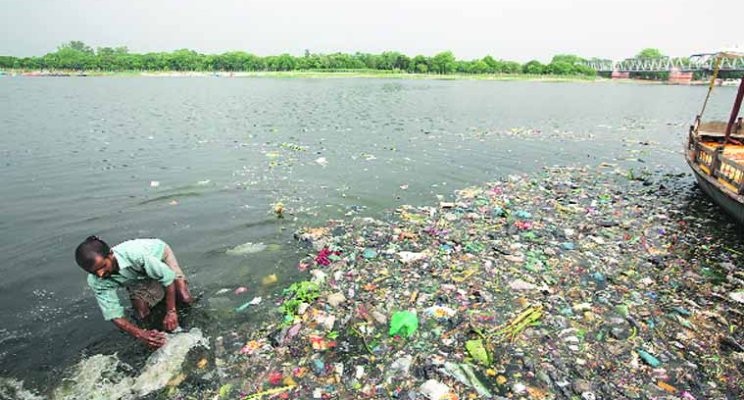
-By Dr. Armin Rosencranz, Prof. of Law & Dushyant Kaul, Student, Jindal Global Law School
By putting the NGT in charge of monitoring the Ganga, the Supreme Court has highlighted the ineptitude of the central government, which has failed to take major action for more than 30 years, despite the constant reproach of the judiciary.
The Supreme Court on January 24 directed the principal bench of the National Green Tribunal (NGT), a special tribunal set up by parliament to deal with environmental issues, to monitor the government’s actions on the cleaning of river Ganga. A bench, comprising Chief Justice J.S. Khehar and Justice N.V. Ramana, asked the NGT to supervise the discharge of municipal sewage and directed it to submit a report within six months on the government’s progress. Earlier, the court had asked the NGT to monitor the treatment of industrial effluents. The lack of initiative by the civic authorities has prompted the court to put their actions under the scrutiny of the NGT too.
The central government provided an update to the court on the work being done under the Ganga Action Plan, which had a disbursement last month of Rs 20,000 crores since receiving cabinet approval. The prime minister had approved this increase in funds under the flagship programme for the rejuvenation of the river in May 2015. The approval of Rs 20,000-crore for the next five years marks a significant four-fold increase over spending on Ganga cleanup during the past 30 years. The Centre has incurred an overall expenditure of approximately Rs 4,000 crore for Ganga rejuvenation since 1985.
The solicitor general stated that the Centre had entrusted the task of assessing 118 identified towns to five public sector undertakings. Having received reports from 84 of these towns, the Centre had leaned towards sewage treatment plants and annuity-based hybrid models as their priority in this initiative. The government had also suggested zero liquid discharge from common effluent treatment plants as an environmentally sustainable form of treating such effluvia. However, most of the tanneries were not dismantled, norms were not complied with and prescribed pollution standards were constantly ignored since the solicitor general last appeared before the court in 2014. Despite large amounts allocated for Phase I and II of the Ganga Action Plan since 1985, little has been done to effectively use these funds.
M.C. Mehta, an acclaimed public interest lawyer and an active social worker, had first filed a PIL in 1985 on the basis of a newspaper report alleging that Bharat Heavy Electricals Limited was discharging industrial effluents in Bhadrabad (near Haridwar) into the Ganga. The court took cognisance of many such industries located near the riverbank that were polluting the river. It instructed all of them to abide by the standards set out by the Central Pollution Control Board. Interim orders were passed, directing the closure of 20 tanneries that were discharging untreated waste into the river. On January 12, 1988, the court lashed out at municipal councils and instructed them to set up sewage treatment plants to effectively manage untreated wastes. Furthermore, the court recognised the findings of the comptroller and auditor general report that found massive mismanagement of the Ganga cleanup funds and other resources in the Centre as well as the states.
For 30 years, Mehta has been leading the charge against environmental degradation of the Ganga, which flows in eight states in India. Numerous tanneries and industries have desecrated the Ganga, regarded as sacred by millions, over the last 30 years. Since the 1980s, landmark orders against almost 50,000 polluting industries have been passed. Mehta’s sustained efforts have led to the installation of around 250 sewage treatment plants across towns and cities on the banks of the river, and the shutting down of several tanneries. Mehta’s non-profit organisation launched the ‘National Rivers Protection Campaign’ in 1998 in many towns and cities through which the Ganga flows, in an attempt to involve local people and other concerned citizens in spreading awareness.
Dismissing the recent arguments of the government and noting with dismay the apathetic attitude of successive governments in 108 hearings spanning over 32 years, Mehta criticised the “tall claims” made by the government on making the river pollution free. The Supreme Court cited time constraints and said that the NGT was the most suitable authority to monitor the progress of the Ganga on a regular basis. Although Mehta questioned the compliance mechanism of the tribunal, the court clarified that under Chapter VI (S.26 and S.27) of the NGT Act 2010 the tribunal could impose penalties and even imprison offenders. Mehta was given carte blanche to approach the tribunal henceforth to address his grievances.
The NGT’s role
The NGT, which has been hearing the Ganga case since 2014, has consistently shown that it can pursue entities that seek to pollute the environment. This is evident from its inclination to impose and collect damages from various polluters. It passed two landmark orders that certainly made a mark and reminded government authorities and industries that they cannot pollute with impunity. In the Alaknanda Hydro Power Co. case, the tribunal ordered the company to pay Rs 9.26 crore to the victims of the Uttarakhand floods in 2013, since the dam built by them contributed to the floods in the region. Similarly, the NGT slammed a Rs 100 crore fine on Panama-based Delta Marine Shipping Co. for an oil spill that was caused when one of its ships sank off the coast of Mumbai.
These verdicts show the power of the NGT to haul government and private organisations to pay up for any malpractices caused through their neglect or ignorance. They have definitely set the tone for the future. Because of the NGT, the burden to recompense is no longer only on the government but also on liable private parties.
It is remarkable that the Supreme Court has been forced to put the NGT in charge of monitoring the Ganga. This drastic step has shown the ineptitude of the central government, which has failed to take major action for more than 30 years, despite the constant reproach of the judiciary. One can only hope that such a move wakes the government up and stirs it to action to save this vital river of India.
(The article was originally published in The Wire)

